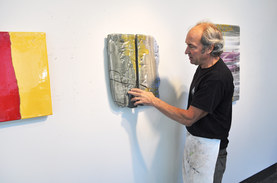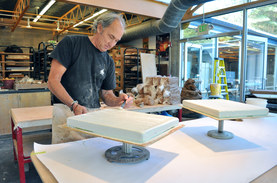
IRIS login | Reed College home Volume 96, No. 2: June 2017
Ambassador of Art
The art of Geoffrey Pagen [ceramics 1987–], director of Reed's ceramic program, will grace the exterior of the new U.S. embassy in Bujumbura, the capital city of Burundi.
Pagen has previously exhibited his work in Nouakchott, Mauritania, and the Democratic Republic of Congo as part of the State Department's Art in Embassies program. Exhibitions feature original works from U.S. and host country artists that are compatible with the values of the host country and complement the architecture and interior design of the space. The installations foster visual diplomacy in more than 200 diplomatic venues worldwide. His piece for Burundi is a commissioned piece that will be permanently affixed to the exterior of the new embassy.

The massive, multi-paneled piece Geoffrey Pagen created for the U.S. embassy in Burundi (not shown) will be installed in October.
One of the five poorest countries in the world, Burundi is a landlocked nation that was beset with civil war through much of the later half of the 20th century. Now a democratic republic, the country was colonized by Belgium and claimed its independence in 1962.
"Burundi kind of followed Rwanda in that they had a civil war with atrocities and murders," Pagen says. "It's a former Belgian colony under King Leopold II, who was a complete rear-end, one of the worst. When Europe carved up Africa they just did what they wanted. They raped, pillaged, mined, and exploited, and then let's not forget the 400 years of slavery. They put a good dent in it."
In March Pagen traveled to Burundi with Bob Soppelsa, senior curator for the Art in Embassies Program, to explore the site. In October the multi-paneled piece, approximately 7.5 feet by 15 feet, will be attached to the colored stone exterior of the new embassy building, which Pagen used as a point of departure for creating the piece.
If it hadn't been for the math required, Pagen might have become an architect like his father. In high school, he worked in an architect's office and came to appreciate that until it is filled with people or objects, architecture is about space — then it becomes a place.
"When you punctuate that space there is an intimacy that humanizes it and changes how you physically move through it," he says. "That's what interests me as an artist."
Working with the elements
Pagen's romance with clay was ignited when he was nine years old. He ditched horse class at summer camp to head to the craft shack for another session of making lanyards. A ceramic potter's wheel behind the shack captured his attention and he began restoring it with the help of his counselor.
A highly malleable, forgiving medium, clay can be frustrating to work with, requiring patience and timing.
"There's an unbelievable amount of waiting," he says. "You're always waiting for something to dry or something to get fired."
Although his medium is clay, Pagen is really a painter who covers the surfaces of his clay tiles with images that are painterly, biomorphic, and abstract. While he appreciates unglazed ceramics, as a painter his own work is about color and the clay takes a subordinate position to the drawing on the surface.
"Clay has these amazing cycles of life, death, and another life," he says. "When it's wet and you're involved with it, that's one life. When it dries and you bisque-fire it, I think it kind of dies. For me, you bring it back to life with color, with glaze."
His work captures the rhythms of the external world, exploring the relationships between proportion and energy. The movement in his pieces often mirrors the dynamism of water. As a boy he grew up surfing in California and came to love the physicality, density, and vibrancy of water.
"As a moving object it's such a powerful material," he says. "I love the difference between a river, a lake, and an ocean."
Keeping the wheel turning at Reed
While only a small percentage of the Reed students are art majors and ceramics is not part of an accredited program, Pagen is overwhelmed by Reed's commitment to it.
"I tell my students that the more you put into this, the more you're going to get out of it. Some of them come when they feel like it and others come every day. Those are the ones that define the validity of the program."
Many students approach making art analytically, but conceptual thinking only goes so far when it comes to making things. Pagen encourages his students to make things that will initiate a conversation.
He faced this challenge for his embassy piece in Bujumbura. In addition to considering budget and scale he had to take into account emblematic issues and imagery that relate to the country and its history.
"Bujumbura is a long ways from Portland and this project was really out of the box for me," he says. "This is an isolated, privileged project that represents a major world government."
Pagen hopes his piece in Africa will be spark conversation for many years to come.
Tags: Burundi embassy, ceramics, Geoffrey Pagen



LATEST COMMENTS
steve-jobs-1976 I knew Steve Jobs when he was on the second floor of Quincy. (Fall...
Utnapishtim - 2 weeks ago
Prof. Mason Drukman [political science 1964–70] This is gold, pure gold. God bless, Prof. Drukman.
puredog - 1 month ago
virginia-davis-1965 Such a good friend & compatriot in the day of Satyricon...
czarchasm - 4 months ago
John Peara Baba 1990 John died of a broken heart from losing his mom and then his...
kodachrome - 7 months ago
Carol Sawyer 1962 Who wrote this obit? I'm writing something about Carol Sawyer...
MsLaurie Pepper - 8 months ago
William W. Wissman MAT 1969 ...and THREE sisters. Sabra, the oldest, Mary, the middle, and...
riclf - 10 months ago